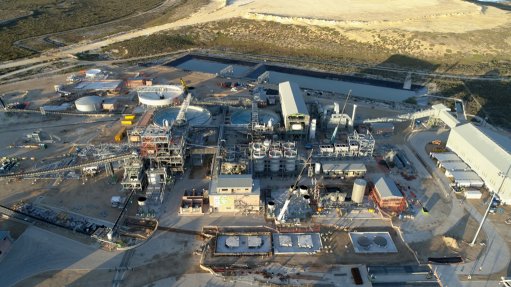
Photo by: Kropz
Name of the Project
Elandsfontein phosphate project.
Location
Saldanha Bay, in the Western Cape, South Africa.
Project Owner/s
The Elandsfontein project is held by Kropz (70%), African Rainbow Capital, or ARC (25%), and a smaller empowerment partnership (5%). Ubuntu Botho Investments forms part of the ARC structure.
Project Description
The Elandsfontein deposit is the biggest sedimentary phosphate deposit in South Africa.
The phosphate mineralisation is contained in the Varswater formation, with the phosphate occurring in phosphatised shell fragments and phosphorite pellets. The remainder of the deposit consists of silica sand and calcium oxide.
The project has an initial mine life of about 14 years and can deliver one-million tonnes a year of phosphate rock concentrate at steady state.
The processing plant will produce a final saleable concentrate to the expected specification of 68% bone phosphate of lime and about 31% phosphorus oxide using a flotation configuration of direct flotation, followed by a reverse flotation circuit.
Potential Job Creation
Not stated.
Net Present Value/Internal Rate of Return
Not stated.
Capital Expenditure
Kropz has spent $120-million to bring its Elandsfontein phosphates mining and processing project into production and requires an additional $16-million to cover its augmentation.
Planned Start/End Date
While the project was first scheduled to start producing phosphate in 2018, it reported first production of phosphate rock concentrate only on March 18 this year.
The Elandsfontein project has been plagued by various delays since October 2017, when its water-use licence was contested by an environmental protection group. Other challenges have included changes to its processing plans and Covid-19-related delays.
Latest Developments
Kropz has announced an increase in the total phosphate resources to 106-million tonnes at the Elandsfontein phosphate project.
However, the company has had to downgrade much of the previously measured resource to indicated status and also downgrade previously indicated resources to inferred status.
The total measured and indicated resource tonnage has reduced by about 76%.
The company has been undertaking infill drilling, relogging of historical cores and mapping of ore exposures to increase the company’s level of confidence in the project, and allow for accurate and efficient mine planning.
Based on current conditions and on-site learnings, as well as revised geological interpretations, in addition to new intersections of unknown and undefined indurated phosphatic lenses during mining activity, Kropz has considered it prudent that the resource model be reclassified.
The updated resource now considers core recovery, average drill-hole spacing and sample count. The grade has improved, with the refined lithological contacts and improved estimates from the infill drilling and pit sampling.
The Elandsfontein project has proven reserves of 7.31-million tonnes grading 10.71% phosphorous pentoxide.
CEO Mark Summers says that while the downgrade of the measured and indicated resource is disappointing, it enables Kropz to progress with a significantly increased level of confidence.
The company contends that the increase in total resource and, more importantly, the increase in grade, as well as continued drilling planned for the year ahead, will further increase confidence and support in increasing reserve tonnes.
Key Contracts, Suppliers and Consultants
DRA (engineering, procurement and construction management); Minopex (processing plant operation); and VDM Transport.
Contact Details for Project Information
Kropz, tel +27 21 930 0927 or email info@kropz.com.